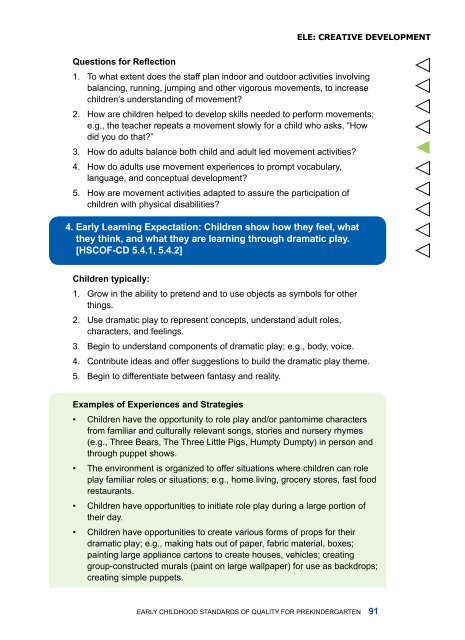Early Childhood Standards of Quality for ... - State of Michigan
Early Childhood Standards of Quality for ... - State of Michigan
Early Childhood Standards of Quality for ... - State of Michigan
Create successful ePaper yourself
Turn your PDF publications into a flip-book with our unique Google optimized e-Paper software.
ELE: Creative DevelopmentQuestions <strong>for</strong> Reflection1. To what extent does the staff plan indoor and outdoor activities involvingbalancing, running, jumping and other vigorous movements, to increasechildren’s understanding <strong>of</strong> movement?2. How are children helped to develop skills needed to per<strong>for</strong>m movements;e.g., the teacher repeats a movement slowly <strong>for</strong> a child who asks, “Howdid you do that?”3. How do adults balance both child and adult led movement activities?4. How do adults use movement experiences to prompt vocabulary,language, and conceptual development?5. How are movement activities adapted to assure the participation <strong>of</strong>children with physical disabilities?4. <strong>Early</strong> Learning Expectation: Children show how they feel, whatthey think, and what they are learning through dramatic play.[HSCOF-CD 5.4.1, 5.4.2]Children typically:1. Grow in the ability to pretend and to use objects as symbols <strong>for</strong> otherthings.2. Use dramatic play to represent concepts, understand adult roles,characters, and feelings.3. Begin to understand components <strong>of</strong> dramatic play; e.g., body, voice.4. Contribute ideas and <strong>of</strong>fer suggestions to build the dramatic play theme.5. Begin to differentiate between fantasy and reality.Examples <strong>of</strong> Experiences and Strategies• Children have the opportunity to role play and/or pantomime charactersfrom familiar and culturally relevant songs, stories and nursery rhymes(e.g., Three Bears, The Three Little Pigs, Humpty Dumpty) in person andthrough puppet shows.• The environment is organized to <strong>of</strong>fer situations where children can roleplay familiar roles or situations; e.g., home living, grocery stores, fast foodrestaurants.• Children have opportunities to initiate role play during a large portion <strong>of</strong>their day.• Children have opportunities to create various <strong>for</strong>ms <strong>of</strong> props <strong>for</strong> theirdramatic play; e.g., making hats out <strong>of</strong> paper, fabric material, boxes;painting large appliance cartons to create houses, vehicles; creatinggroup-constructed murals (paint on large wallpaper) <strong>for</strong> use as backdrops;creating simple puppets.<strong>Early</strong> <strong>Childhood</strong> <strong>Standards</strong> <strong>of</strong> <strong>Quality</strong> <strong>for</strong> Prekindergarten 91


